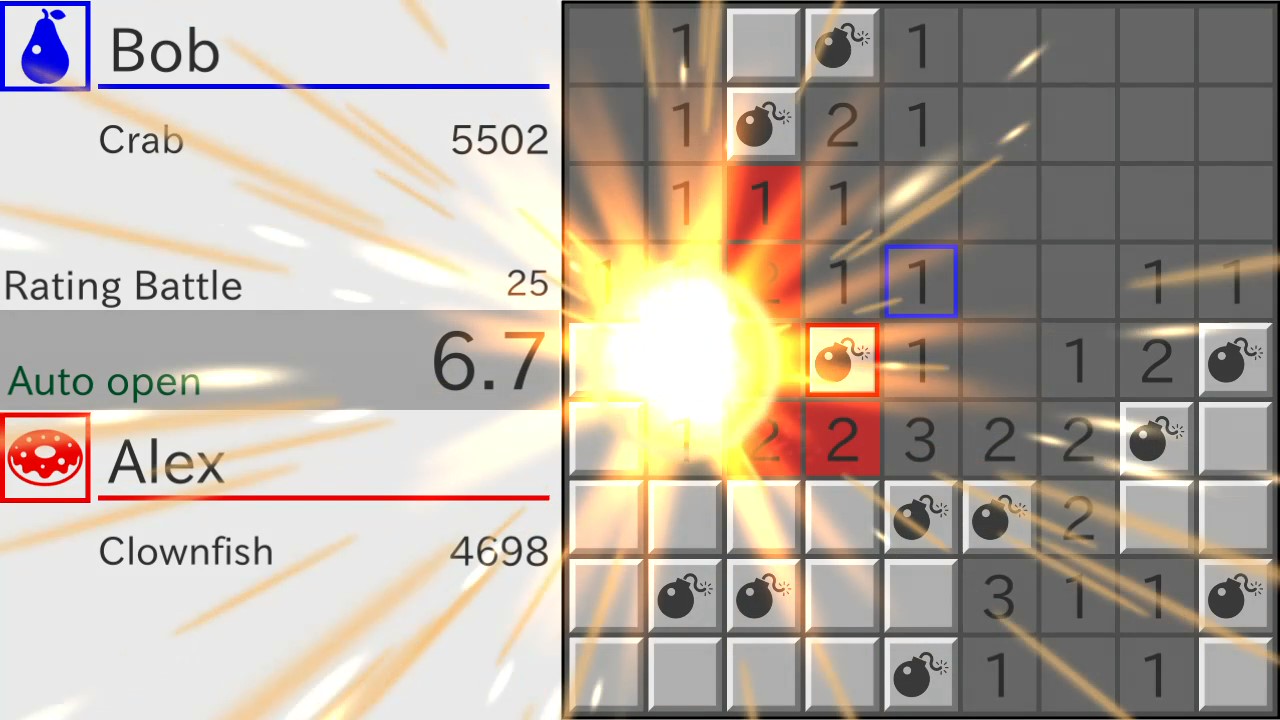
Battle Minesweeper Online

Details
- MSRP: $3.99
- Release date: May 9, 2024
- Genre: Puzzle, Action, Board Game, Education
- Number of players:
- Offline: 1
- Online: 2
- Developer: Blacksmith DoubleCircle
- Publisher: Blacksmith DoubleCircle
- Download size: 126 MB
- Metacritic: tbd tbd
- ESRB Rating: Everyone
- Play modes: TV, Tabletop, Handheld
- Languages: Japanese, English
- Platforms: Nintendo Switch
Current prices
|
|
Switch
Digital |
$3.99
|
Price history
| All time low | |
| $1.99 | (-50%) |
Description
Battle Minesweeper Online is a real-time online battle game that you can easily enjoy.
Recognition, logical thinking, judgment, reaction speed, and luck are tested.
- Mode
You can play Rating Battle and Password Battle and CPU Battle.
In Rating Battle, matching will be done so that you will be matched against opponents with similar ratings.
If you win in a Rating Battle, your rating will go up, and if you lose, your rating will go down.
Increase your rating and get your name on the Ranking.
In Password Battle, matching is done so that people who have entered the same password will compete against each other.
It can be used when you want to play with acquaintances, or when broadcasters want to interact with viewers.
In CPU Battle, you can play against a variety of CPUs.
In "Simple" mode, if you win one game, the CPU's level will increase, allowing you to face different CPUs.
In "Gradual" mode, if you achieve a perfect win or win three times in a row, the CPU's level will increase.
Low-level CPUs are weak, but higher-level CPUs will open tiles more quickly and accurately.
Hone your skills to defeat stronger CPUs.
You can also play CPU Battle while matchmaking for Rating Battle.
- Battle Flow
- If matching is successful, a 1-on-1 game between you and your opponent will begin.
- 1 or 2 tiles will be automatically opened at the start of the game.
- Move the cursor to open non-mine tiles.
- The game ends when all non-mine tiles are opened, or when either you or your opponent opens a mine tile.
- The player who opens the mine tile loses.
If the game ends without a mine tile being opened, the score is calculated according to the number of times the tile was opened, and the player with the most points wins.
(1 point if you open a tile adjacent to a mine. 3 points if you open a tile that is not adjacent to a mine)How to Play
Left stick or directional buttons: Move
A button: Confirm, Open Tile
Y button: Fast Move
B button: Cancel, Remove Flag
X button: Set Flag on TileDetailed Rules
-- The number written on a tile
The number written on a tile is the number of mines adjacent to that tile.
For example, when a tile shows '1', among the 8 tiles adjacent to that tile, 1 of them is a mine tile. The remaining 7 tiles are safe to open as they do not contain mines.
Similarly, when a tile shows '2', among the 8 tiles adjacent to that tile, 2 of them are mine tiles. The remaining 6 tiles are safe to open as they do not contain mines.
You can figure out where the mine tiles are located by observing the numbers on the tiles.
-- Auto Open
1 or 2 tiles will be automatically opened at the start of the game.
If neither you nor your opponent opens a tile within 7.5 seconds, 1 or 2 tiles will be automatically opened randomly.
-- Flag
You can set a flag as a marker with X.
You can remove the flag with B.
Setting a flag will not affect your score.
The flag you set cannot be seen by your opponent.
-- Cursor
Your cursor is red.
The opponent's cursor is blue.
When the cursors collide, sparks will fly.
-- Purple
Collision detection may fail due to a network delay.
If your cursor overlaps with your opponent's cursor, the cursor will turn purple.
Due to network delays, if you open a tile before your opponent's tile open information arrives, you and your opponent may end up opening the same tile. In that case, the tile color will be purple, and both you and your opponent will score the same number of points.
-- Network Delay
Online battles proceed by sending your controller operation information to your opponent and receiving your opponent's controller operation information.
There is a short but not negligible amount of time between when information is sent and when it is received.
For a short period of time from when information is sent until it is received, there will be some inconsistency between your screen and your opponent's screen.
The delay caused by communication like this is referred to here as network delay.
Videos












